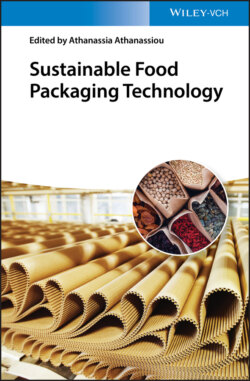Читать книгу Sustainable Food Packaging Technology - Группа авторов - Страница 35
2.1 Introduction
ОглавлениеThe main function of food packaging is to protect products from chemical, physical, and biological deteriorating effects, thereby extending food shelf life [1], although packaging is also used as a marketing tool to communicate with consumers [2]. Packaging materials include paper, glass, aluminum, steel, and polymers. Among them, polymeric materials show some advantages such as lightness and processability, allowing the production of flexible pouches, bags, or rigid containers of various shapes and sizes [3]. Thus, they have been extensively used to contain and protect fresh food products. Nevertheless, petroleum‐based polymeric materials lead to serious environmental issues because they generate extensive volumes of waste after disposal, considering that approximately 40% of plastic products have a service life of less than one month [4]. Moreover, even if there is an increasing awareness of recycling, the most common materials utilized for food packaging have a limited recyclability (e.g. thermoplastics) or they are hardly recyclable (e.g. thermoset plastics) [5]. In that way, 30% of plastic packaging materials may never be eligible for recycling or reuse without a fundamental redesign [6]. In this regard, ongoing research is focused on sustainable alternatives, giving special emphasis to films and coatings derived from renewable sources. Among biopolymers, proteins and polysaccharides, which are long chain hydrophilic polymers known as hydrocolloids, can be found. These hydrocolloids are capable of forming viscous dispersions or gels in water, providing easy handling for film and coating preparation [7]. In general, hydrocolloid films and coatings exhibit good barrier properties to oxygen, carbon dioxide, and lipids [8–10]. In terms of mechanical properties, protein‐based films present greater flexibility but lower tensile strength than polysaccharide‐based films [11].
Using renewable packaging materials is not a novel strategy, since some ancient human practices of food preservation were based on renewable raw materials. For instance, fruit waxing has been used since the twelfth century in China, meat larding has been employed in England since the sixteenth century, as well as wrapping ground meats or vegetables with soy films in the Orient [11]. Currently, considerable progress has been made in developing packaging based on renewable materials, among them, films and coatings based on biopolymers derived from marine sources [12]. Thereby, by‐products from seafood industry can be used in the development of environmentally friendly packaging solutions to prevent food spoilage and extend shelf life [13].
Figure 2.1 Fishery production, wastage, and possible solutions.
The global fish production (fish, crustaceans, mollusks, and other aquatic animals, including fisheries and aquaculture) peaked at about 171 million tons in 2016 [14], with an estimated loss or wastage between landing and consumption of 27% of landed fish, crustaceans, and mollusks (Figure 2.1). Additionally, high amounts of solid waste generated in fishery industries must be considered; for instance, in fish canning operations, the amount of waste can be as high as 50% by weight of raw products [15]. In all these fish by‐products (skin, bones, scales, tendons), there is a considerable amount of collagen, a fibrous protein with a structural function [16, 17]. Carrying out thermal denaturation or partial hydrolysis of collagen, gelatin is obtained [18], whose properties differ between fish species. In general, cold‐water fish gelatins have relatively lower gel strength than warm‐water fish gelatins due the lower content of imino acid residues [19]. In this regard, gelatin from salmon skin (cold‐water fish) has 166 residues per 1000 total amino acid, whereas gelatin from sea bass skin (warm‐water fish) contains around 198–202 residues per 1000 total amino acid [20].
In the case of crustacean and mollusks by‐products, shrimp and crab shells can be used to obtain chitin [21]. As an example, lobster processing industry by‐products account for around 75% by weight of the starting material (Figure 2.1). Chitin has a similar structural function to that of collagen. Chitin is the second most abundant natural polymer after cellulose, and it is usually transformed into chitosan, a water‐soluble polymer, to broaden its application. This transformation process is based on chitin deacetylation under alkaline conditions [22–24]. It must be considered that the functional properties of chitosan depend on structural features, such as average molecular weight and degree of deacetylation [25].
This chapter provides an overview of packaging films and coatings based on biopolymers derived from marine sources, with emphasis on fish gelatin and chitosan materials. The techniques used for extraction of biopolymers, preparation methods of films and coatings, and their characterization, together with diverse novel techniques employed for extending food products shelf life, will be described in this chapter.
